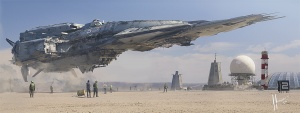Striker-class Destroyer: Difference between revisions
Asid Mjolnir (talk | contribs) mNo edit summary |
Asid Mjolnir (talk | contribs) mNo edit summary |
||
| Line 101: | Line 101: | ||
==Deck Listing== | ==Deck Listing== | ||
*Deck 01: Bridge, Communications Center, Captain's Quarters, Coilgun Magazine & Battery, Grappling Cannon | *Deck 01: Bridge, Communications Center, Captain's Quarters, Coilgun Magazine & Battery, Grappling Cannon | ||
*Deck 02: Torpedo Magazine, Shuttle Hangars, Medical Bay Crew Quarters, Power Core, Mess Hall | *Deck 02: Torpedo Magazine, Shuttle Hangars, Medical Bay, Crew Quarters, Power Core, Mess Hall | ||
*Deck 03: Coilgun Magazine & Battery, Storage, Water Reclamation, Grappling Cannon</onlyinclude> | *Deck 03: Coilgun Magazine & Battery, Storage, Water Reclamation, Grappling Cannon</onlyinclude> | ||
Revision as of 00:38, 13 July 2020

| |
|---|---|
| Class Overview | |
| Name: | Striker-class Destroyer |
| Designation: | D |
| Manufacturer: | The Initiative |
| Succeeded By: | Warrior-class Destroyer |
| Planned: | 29 |
| Completed: | 29 |
| Decommissioned: | 14 |
| Destroyed: | 15 |
| Technical Specifications | |
| Function: | Light Escort |
| Size: | Length: 115 Meters Beam: 12 Meters Draft: 7 Meters |
| Sublight Speed: | 15KM/s (Full Military Thrust) |
| FTL Speed: | 8Ly/H |
| Standard Complement: | War Era: 100 Officers & Crew Post-War: 70 Officers & Crew |
| Armaments: | 8x Coilgun (6 or 8 inch) 2x Torpedo Launchers 2x Grappling Cannon |
| Hull: | Titanium Alloy |
| Shield Generators: | Single Light Energy Shield Generator (Post War Only) |
| Auxiliary Craft: | 2x Porter-class Shuttles |
The Striker-class Destroyer was constructed as a light escort for larger vessels during the War of Secession, prior to the Fall of Earth. Following the war, many were sold off or were decommissioned.
History
The first Striker-class destroyers were launched in 2020 CE, prior to the Fall of Earth during the War of Secession. They were constructed predominantly to counter the lighter United Earth Forces vessels, as well as serve as an anti-missile screen for larger capital vessels. Following the war, they served as escorts to the planet in the weeks following the war to protect transports from air assaults, and to prevent any military forces posing as colonists from seizing control of the transports.
Following the war, more were built to combat pirates and to serve as fast, armed, couriers for the government. Because of the large number of jumps conducted by many of the vessels without shielding, the Striker-class suffered the largest number of lost or damaged vessels than any other warship class to date, and only closely approached by the unshielded Archer-class frigate's losses.
The Striker-class began being downsized in the mid-2200s, as design and construction work began on the Warrior-class. With many of the Striker-class vessels were approaching over a century of use, the oldest vessels were approaching a full two centuries of rigorous use, several of the oldest vessels were decommissioned early. This was done in part due to the rapidly rising costs of maintaining vessels of that age, which were further aggravated by systems not included in the initial design.
The Striker-class were officially retired from active combat service, relegated to convoy escorts, in 2150 CE after a series of skirmishes against pirates proved their inability to combat modern warships. Many of the newer Strikers began conducting decommissioning and demilitarization, and by 2166 CE the last Striker-class vessels had been decommissioned and scrapped, demilitarized, or mothballed.
Basic Specifications
Size
- Length: 115 Meters
- Beam: 14 Meters
- Draft: 10 Meters
- Decks: 3
Crew Complement
- Minimum: 15 (War Era) / 5 (Post-War Refits)
- Standard: 100 (War Era) / 70 (Post-War Refits)
- Maximum: 200
Engines
|
|
Power Plant
|
|
Hull Composition
- Hull: Titanium Alloy
- Armor Plating: 1.25 meter Case-hardened Steel, Titanium, & Ceramic Composite Plates over a .50 meter thick synthetic diamond sheath (Post-war retrofits)
- Armor Plating: Synthetic composites, case-hardened steel, ceramic plates (War era)
Sensor System
|
|
Defensive Systems
|
|
Armament
|
|
Auxiliary Craft
Other Systems
|
|
Deck Listing
- Deck 01: Bridge, Communications Center, Captain's Quarters, Coilgun Magazine & Battery, Grappling Cannon
- Deck 02: Torpedo Magazine, Shuttle Hangars, Medical Bay, Crew Quarters, Power Core, Mess Hall
- Deck 03: Coilgun Magazine & Battery, Storage, Water Reclamation, Grappling Cannon
Known Vessels
Credit
- Image: DeviantArt
- Credit to JJasso. Used with permission.